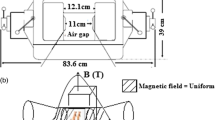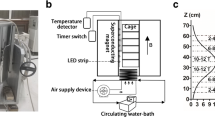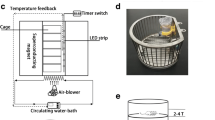Abstract
Electromagnetic fields (EMFs) can affect living cells due to biochemical changes, followed by changes in levels of trace elements in serum and different organs. This study focuses on the effect of whole body exposure to EMF, presented everywhere in our environment, and on the levels of trace elements in serum, femur, brain, kidney, and liver tissues. The analyses performed on 29 guinea pigs were divided into five groups. Guinea pigs were exposed to a magnetic field of 50 Hz of 1.5 mT. Groups A and B were exposed to the magnetic field for a period of 4 h/day continuously (4 h/day) for 4 and 7 days, respectively. Groups C and D were exposed to the magnetic field for a period of 4 h/day intermittently for 4 and 7 days, respectively. Group E animals were enrolled as control. Copper (Cu), zinc (Zn), calcium (Ca), and magnesium (Mg) levels were determined by atomic absorption spectroscopy in serum, femur, brain, kidney, and liver tissues in all guinea pigs. When compared to the control groups, the changes in the levels of Cu in serum samples, femur, and kidney tissues of the treated groups were statistically significant. The same was also true for the levels of Mg in the brain, kidney, and lung tissues. Our results suggest that in vivo continuous and intermittent exposure to EMF may cause disturbances in homeostasis of bioelements. These effects could be important risk factors for toxic effects of EMF, especially in relation to deterioration of bioelements.
Similar content being viewed by others
References
Singh AP, Kaur R (2014) Electromagnetic fields: biological implications on various life forms. Int J Bioassays 3:2030–2040
Hong MN, Han NK, Lee HC, Ko YK, Chi SG, Lee YS, Gimm YM, Myung SH, Lee JS (2012) Extremely low frequency magnetic fields do not elicit oxidative stress in MCF10A cells. J Radiat Res 53:79–86
Burchard JF, Nguyen DH, Block E (1999) Macro- and trace element concentrations in blood plasma and cerebrospinal fluid of dairy cows exposed to electric and magnetic fields. Bioelectromagnetics 20:358–364
Fadel A, Wael M, Mostafa M (2003) Effect of 50 Hz, 0.2 mT magnetic fields on RBC properties and heart functions of albino rats. Bioelectromegnetics 24:535–545
Hanafy E, Elhafez S, Aly F, Elazhary M (2008) Loss of bone calcium in exposure to 50 Hz magnetic fields. Electromagn Biol Med 27:402–408
Coskun O, Comlekci S (2001) Effect of ELF electric field on some on biochemistry characters in the rat serum. Toxicol Ind Health 27:329–333
WHO (1996) World Health Organization, Trace Elements in Human Nutrition and Health, Geneva
Ulku R, Akdag MZ, Erdogan S, Akkus Z, Dasdag S (2011) Extremely low-frequency magnetic field decreased calcium, zinc and magnesium levels in costa of rat. Biol Trace Elem Res 143:359–367
Rana SV (2008) Metals and apoptosis: recent developments. J Trace Elem Med Biol 22:262–284
Seyhan N, Canseven AG, Guler G (2006) Animal studies on the effects of ELF and static EMF. Bioelectromagnetics: current concepts. In: Ayrapetyan S, Markov M (eds) NATO science series. Springer Press, Dordrecht, pp 195–212
Seyhan N, Canseven AG (2006) In vivo effects of ELF MFs on collagen synthesis, free radical processes, natural antioxidant system, respiratory burst system, immune system activities and electrolytes in the skin, plasma, spleen, lung, kidney and brain tissues. Electromagn Biol Med 25:291–305
Canseven AG, Seyhan N, Mirshahidi S, Imir T (2006) Suppression of natural killer cell activity on Candida stellatoidea by a 50 Hz magnetic field. Electromagn Biol Med 25:79–85
Brodziak-Dopierala B, Kwapulinski J, Kusz D, Gajda Z, Sobczyk K (2009) Interactions between concentrations of chemical elements in human femoral heads. Arch Environ Contam Toxicol 57:203–210
Arnal N, Cristalli DO, de Alaniz MJ, Marra CA (2010) Clinical utility of copper, ceruloplasmin, and metallothionein plasma determinations in human neurodegenerative patients and their first-degree relatives. Brain Res 1319:118–130
Viktorinova A, Toserova E, Krizko M, Durackova Z (2009) Altered metabolism of copper, zinc, and magnesium is associated with increased levels of glycated hemoglobin in patients with diabetes mellitus. Metabolism 58:1477–1482
Touitou Y, Djeridane Y, Lambrozo J, Camus F (2012) Long-term (up to 20 years) effects of 50-Hz magnetic field exposure on blood chemistry parameters in healthy men. Clin Biochem 45:425–428
Garcia-Sancho J, Montero M, Alvarez J, Fonteriz RI, Sanchez A (1994) Effects of extremely low frequency electromagnetic fields on ion transport in several mammalian cells. Bioelectromagnetics 15:579–588
Liburdy RP, Yost MG (1993) Time varying and static magnetic fields act in combination to alter calcium signal transduction in the lymphocyte. In: Blank M (ed) Electricity and magnetism in biology and medicine. San Francisco Press Inc., San Francisco, pp 331–334
Hwang YH, Song HS, Kim HR, Ko MS, Jeong JM, Kim YH, Ryu JS, Sohn UD, Gimm YM, Myung SH, Sim SS (2011) Intracellular Ca mobilization and beta-hexosaminidase release are not influenced by 60 Hz-electromagnetic fields (EMF) in RBL 2H3 cells. Korean J Physiol Pharmacol 15:313–317
Ghannam MM, El-Gebaly RH, Gaber MH, Ali FM (2002) Inhibition of ehrlich tumor growth in mice by electric interference therapy (in vivo studies). Electromagn Biol Med 21:255–268
Sellmeyer DE, Schloetter M, Sebastian A (2002) Potassium citrate prevents increased urine calcium excretion and bone resorption induced by a high sodium chloride diet. J Clin Endocrinol Metab 87:2008–2012
Canseven AG, Seyhan N, Aydın A, Çevik C, Işımer A (2005) Effects of ambient ELF magnetic fields: variations in electrolyte levels in the brain and blood plasma. Gazi Med J 16:121–127
Watanabe Y, Nakagawa M, Miyakoshi Y (1997) Enhancement of lipid peroxidation in the liver of mice exposed to magnetic fields. Ind Health 35:285–290
Kula B, Sobczak A, Kuska R (2000) Effects of static and ELF magnetic fields on free radical processes in rat liver and kidney. Electromagn Biol Med 19:99–105
Berg H (1993) Electrostimulation of cell metabolism by low frequency electric and electromagnetic fields. Bioelectrochem Bioenerg 31:1–25
Duda D, Grzesik J, Pawlicki K (1991) Changes in liver and kidney concentration of copper, manganese, cobalt and iron in rats exposed to static and low-frequency (50 Hz) magnetic fields. J Trace Elem Electrolytes Health Dis 15:181–188
Kula B, Dro’zdz MA (1996) Study of magnetic field effects on fibroblasts cultures. Part 2, the evaluation of effects of static and extremely low frequency (ELF) magnetic fields on free-radical processes in fibroblasts cultures. Bioelectrochem Bioenerg 39:27–30
Elbetieha A, Al-Akhras MA, Darmani H (2002) Long term exposure of male and female mice to 50 Hz magnetic field: effects on fertility. Bioelectromagnetics 23:168–172
Lee JS, Ahn SS, Jung KC, Kirn YW, Lee SK (2004) Effects of 60 Hz electromagnetic field exposure on testicular germ cell apoptosis in mice. Asian J Androl 6:29–34
Acknowledgements
The authors offer special thanks to Ms. Özge Çevik and Ms. Pınar Targan for syntax corrections of manuscript in point of English. The authors thank Dr. Mehmet Zahid Tüysüz and Arın Tomruk for their contributions on exposure experiments. The work was supported by Gazi University Scientific Research Grant (BAP: 01/2004-96).
Author information
Authors and Affiliations
Corresponding author
Ethics declarations
All animals received human care according to the criteria outlined in the “Guide for the Care and Use of Laboratory Animals” prepared by the National Academy of Sciences and published by the National Institutes of Health, USA. The experimental design of this study was approved by the Gazi University Ethics Research Committee of Animal Experiments (GU. ET-April 26, 2006, B.30.2.Day.0.EU.00.00/39-5858).
Conflict of Interest
The authors declare that they have no conflict of interest.
Additional information
Cemal Akay is retired.
Rights and permissions
About this article
Cite this article
Erdem, O., Akay, C., Cevher, S.C. et al. Effects of Intermittent and Continuous Magnetic Fields on Trace Element Levels in Guinea Pigs. Biol Trace Elem Res 181, 265–271 (2018). https://doi.org/10.1007/s12011-017-1053-8
Received:
Accepted:
Published:
Issue Date:
DOI: https://doi.org/10.1007/s12011-017-1053-8




